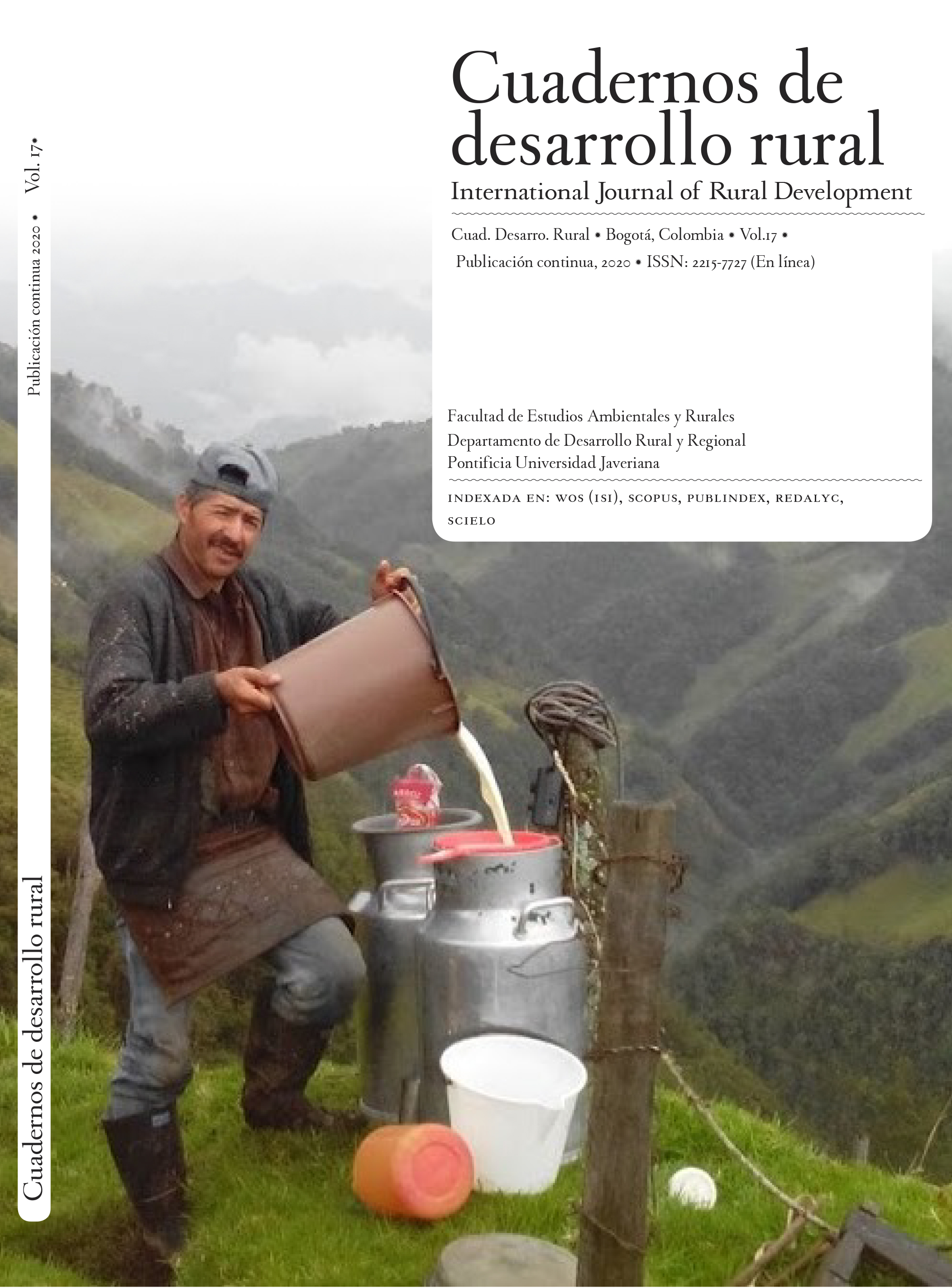Resumen
A pesar de las diferencias regionales, en los estudios sobre ingresos rurales en Irán no se ha abordado la distribución espacial. La meta primordial de este estudio es analizar el patrón espacial de la desigualdad en las áreas rurales del país. En esta investigación se han usado el índice I de Moran, el índice de Theil y el coeficiente Gini durante el periodo 2005-2015. Los resultados muestran que tanto los componentes inter-regionales como los intra-regionales afectan la distribución desigual de los ingresos rurales, aunque la importancia del componente intra-regional es levemente más alta. El estudio de los datos obtenidos con el índice I de Moran muestra que hay evidencia del fenómeno de clustering espacial en la economía rural del país.
Aligoli, M. (2017). Impact of Banking Facility Granted on Agricultural Income Distribution on Iran. Journal of agricultural economic research, 9(4), 67-84.
Arabi, M., and Khodaparastmashhadi, M. (2014). Comparison of social welfare, income distribution and poverty among rural households in north Khorasan and Iran during 2005-2011. Rural Development Strategies, 1(2), 50-35.
Arestis, P., & Baltar, T. C. (2017). Income distribution and economic growth: a Critical Approach. Panoeconomicus, 64(2), 125-138. https://doi.org/10.2298/PAN1702125A
Badri, M. (2007). Dimensions of Industrial Location Factors: Review and Exploration. Journal of Business and public affairs, 2, 1-26.
Bani Assadi, M., & Vermesyari, H. (2014). Investigating factors affecting agricultural labor productivity, distribution of income and poverty in rural Areas of Iran. Quarterly Journal of rural Development, 17(4), 23-1.
Barro, R. J., & Martin, X. S. (1990). Convergence across States and Regions. Brookings Papers on Economic Activity, 1, 1991.
Beheshti, M., Mohammadzadeh, P., & Jamshidi, O. (2018). Investigating Inequality of Income Distribution among Provinces of Iran Using Exploratory Spatial Data Analysis Approach. Quarterly Journal of Economic Research and Policies, 58(26), 150-109.
Bertolini, P., & Pagliacci, F. (2017). Quality of life and territorial imbalances. A focus on Italian inner and rural areas. Bio-based and Applied Economics, 6(2), 183-208. https://doi.org/10.13128/BAE-18518
David, A., Gulibert, N., Hamaguchi, N., Highashi, Y., Hino, H., & Shifa, M. (2018). Spatial poverty and inequality in South Africa: A municipality level analysis. ADF Research Papers Series, (66). ISSN: 2492 – 2846.
Dehgani, A., Hosaini, M., Fatahi, M., & Hekmatifarid, S. (2017). Investigating the Relationship Between Economic Growth and Income Distribution in Iran during 1971-2014. Journal of Applied Economic Studies, 6(21), 226-213. https://doi.org/10.1016/j.rser.2017.05.251
El Benni, N., Finger, R., Mann, S., & Lehmann, B. (2012). The distributional effects of agricultural policy reforms in Switzerland. Agric. Econ. – Czech, 58, 497-509. https://doi.org/10.17221/215/2011-AGRICECON
Fischer, M., & Getis, A. (2009). Handbook of Applied Spatial Analysis: Software Tools, Methods and Applications. Springer Science & Business Media.
Flachsharth, I., Schotte, S., Lay, J., & Garrido, A. (2018). Rural structural change, poverty and income distribution: evidence from Peru. J Econ Inequality, 16(4), 631–653. https://doi.org/10.1007/s10888-018-9392-z.
Goodchild, M. F., & Janelle, D. (2004). Spatially Integrated Social Science. Oxford University Press.
Hoover, E. (1948). The Location of Economic Activity. McGraw-Hill.
Hoffmeister, O. (2009). The Spatial Structure of Income Inequality in the Enlarged EU. The Review of Income and Wealth, 55(1), 101–127. https://doi.org/10.1111/j.1475-4991.2008.00308.x
Isard, W. (2006). Location and Space-economy. A general theory relating to industrial location, market area, land use, trade and urban structure. The Technology Press of Massachusetts Institute of Technology and John Wiley & Sons, Inc.
Jordaan, A. C., Drost, B. N., & Makgata, M. A. (2015). Land value as a function of distance from the CBD: The case of the eastern suburbs of Pretoria. South African journal of economic and management sciences, 7(3), 532-541. https://doi.org/10.4102/sajems.v7i3.1363
Mortazavi, A., Serajzadeh, F., & Shokohi, M. (2011). Study of the relationship between income inequality and economic growth in urban and rural areas of the country, application of Kuznets curve. Journal of agricultural economic research, 3(1), 165-180.
Rahimibadr, B. (2013). Estimation of income distribution pattern of urban and rural areas of Iran using different functional forms specified for Lorenz curve. Quarterly Journal of Economic Strategies, 2(4), 120-96.
Rahmani, T., & Hasanzadeh, E. (2011). Impact of immigration on economic growth and regional convergence in Iran. Journal of economic modeling research, 2(5), 1-19.
Rey, S. J., & Montouri, D. (1999). US Regional Income Convergence: A Spatial Econometric Perspective. Regional studies, 33(2), 143-156. https://doi.org/10.1080/00343409950122945
Sandmo, A. (2015). The principal problem in political economy: income distribution in the history of economic thought. Handbook of income distribution, 2(2), 3-65. https://doi.org/10.1016/B978-0-444-59428-0.00002-3.
Schaltegger, C., & Weder, M. (2014). Austerity, inequality and politics. European journal of political economy, 5, 1-22. https://doi.org/10.1016/j.ejpoleco.2014.03.005
Seperdost, H., & Zamanishabkhnae, S. (2014), Investigating the factors affecting the
distribution of income in rural areas with emphasis on information and communication technology. Quarterly journal of rural development strategies, 1(1), 39-29.
Shahabadi, A., & Mehritalyabi, F. (2017). Impact of accumulation of domestic and foreign research and development in agricultural sector on rural income distribution in Iran. Agricultural economics research, 9(3), 132-117.
Shahbazi, K., Rezaie, E., & Hamidirazi, D. (2015). Economic convergence review of ECO countries: A spatial econometric approach. Quarterly journal of business, 74(1), 196-155.
Sulocic, D. (2014). Did economic inequality cause the economic crisis? Panoeconomicus, 3, 369-387. https://doi.org/10.2298/PAN1403369S.
Fujii, T. (2013). Geographic decomposition of inequality in health and wealth: evidence from Cambodia. The Journal of Economic Inequality, 11(3), 373–392. https://doi.org/10.2139/ssrn.1069475
Wang, Y., Wang, M., Wu, D., Zhao, L., & Ding, J. (2017). Spatial patterns and determinants of rural poverty: A case of Guizhou province, China. Scintia geogeraphica sinica, 2(37), 217-227. https://doi.org/10.13249/j.cnki.sgs.2017.02.007
Wardhana, D., & Ihle, R. (2017). Agro-cluster and poverty. A spatial perspective for West Java. Bulletin of Indonesian Economic Studies, 53(2), 161–86. https://doi.org/10.1080/00074918.2017.1298722
Zhao, J. (2014). Rural income diversification patterns and their determinants in China. Agric. Econ. – Czech, 60, 219-231. https://doi.org/10.17221/97/2013-AGRICECON

Esta obra está bajo una licencia internacional Creative Commons Atribución 4.0.
Derechos de autor 2020 Mohammad Aghapour sabbaghi


